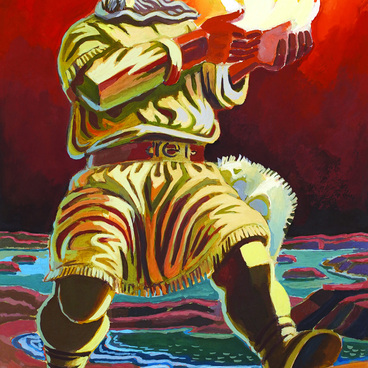Yuri Konstantinovich Lyukshin is an artist, painter, illustrator, art critic, and teacher. He was born in Leningrad in 1949 and graduated from the Valentin Serov Art College in 1971. He has been a member of the Russian Union of Artists since 1978 and the International Association of Art Critics since 1998. Lyukshin was awarded the title of Honored Artist of Russia in 2007. The artist has participated in over 300 exhibitions, both in Russia and internationally, including approximately 70 solo exhibitions.
The Sampo is a central image in Karelian folklore. The main conflict and the main plotline of the Karelian and Finnish epic poem “Kalevala” is largely built around the story of the Sampo: the residents of two rival countries — Kalevala and Pohyola — fight for the Sampo. In the end, the people of Kalevala prevail in this struggle.
The hostess of Pohyola, the old witch Louhi, promises to marry her daughter to the person who would give her the Sampo. When she receives the Sampo from a suitor, Louhi locks it in a copper mountain, where it begins to grow roots, spreading into the ground, the sea, and deep into the forest.
The protagonist of the poem, “eternal wisdom-singer” Wainamoinen, goes to retrieve the Sampo from beneath the mountain. He embarks on this mission because the Sampo, forged by the blacksmith Ilmarinen, is supposed to bring happiness to the people of Kalevala. Instead, it is hidden from the world by the wicked northern witch. The three central characters in Karelian and Finnish mythology — the singer Wainamoinen, the blacksmith Ilmarinen, and the cheerful hunter Lemminkainen — bring the Sampo onto a boat and take it away. The old woman transforms into a bird and pursues the “floating treasure, ” attempting to catch up to the thieves and retrieve the Sampo.
Louhi overtakes the boat of Wainamoinen and his companions. During the ensuing struggle, the Sampo falls into the sea and breaks. The sunken fragments are scattered on the sea bed, and according to Karelian and Finnish mythology, the depths of the sea still contain many mysterious underwater treasures.
The myth about the fate of the Sampo encompasses
not only the idea of personal prosperity, but also a broader understanding of
the surrounding world. After breaking, the Sampo gives its wealth to the water:
salt made the water in the sea saline, and flour made it “fertile, ” as people
in the north rely on water for food (fish and marine animals).



